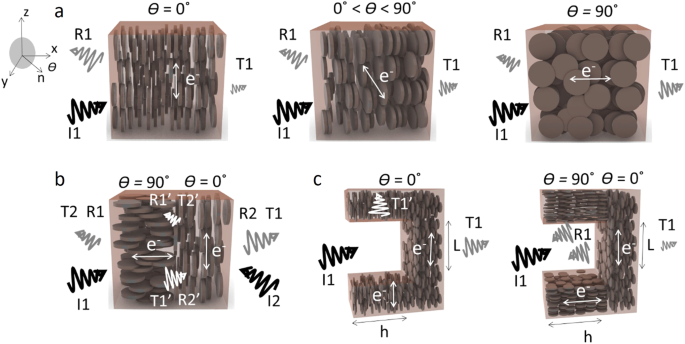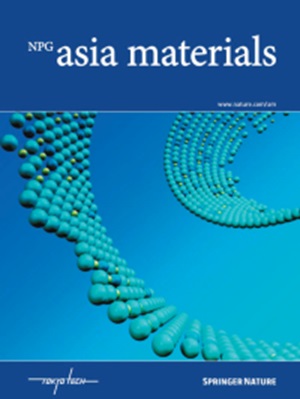Modulation of the electromagnetic shielding effectiveness through micro/macrostructure design for electronic packaging
IF 8.3
2区 材料科学
Q1 MATERIALS SCIENCE, MULTIDISCIPLINARY
引用次数: 0
Abstract
Lightweight electronic packaging that provides mechanical protection, cooling ability, and customizable electromagnetic interference (EMI) shielding effectiveness (SE) is needed for next-generation electronics. Although electronic packaging solutions with excellent EMI SE exist, there is limited research on how hierarchical design can modulate the EMI SE of an electronic packaging material on demand. In this study, the deliberate precise micro/macrostructure design of graphite-based materials using magnetically assisted 3D printing allows tuning of the EMI SE in the X band (8–12 GHz), leading to a maximum total shielding performance of 90 dB. Aligning high-density graphite microplatelets during 3D printing also remarkably amplified the total SE by 200%. Subsequently, rationally designing the oriented microstructure within a geometrical shape increases the reflection and improves the EMI SE from 40 to 60 dB in a specific direction. Our proof-of-concept samples demonstrate the potential of precise micro/macrostructure design for customizing and enhancing electronic packaging’s EMI SE while achieving good heat dissipation and mechanical protection using a versatile 3D printing method. These advances pave the way for more reliable and safer electronic systems. Magnetically assisted 3D printing allows customizable electromagnetic interference (EMI) shielding effectiveness (SE). Aligning high-density graphite microplatelets during the 3D printing parallel or perpendicularly to incident waves leads to their tailored reflection and transmission. Designing the micro/macrostructure of materials allows customization and enhancement of electronic packaging’s EMI SE while achieving good heat dissipation and mechanical protection. These advances pave the way for more reliable and safer electronic systems.


通过微/宏观结构设计调节电子封装的电磁屏蔽效果
下一代电子产品需要能提供机械保护、冷却能力和可定制电磁干扰(EMI)屏蔽效果(SE)的轻型电子封装。虽然目前已有具有出色电磁干扰屏蔽效果的电子封装解决方案,但有关分层设计如何按需调节电子封装材料的电磁干扰屏蔽效果的研究还很有限。在这项研究中,利用磁辅助三维打印技术对石墨基材料进行有意的精确微/宏观结构设计,可以调整 X 波段(8-12 GHz)的 EMI SE,使总屏蔽性能最大达到 90 dB。在三维打印过程中对齐高密度石墨微板还可将总屏蔽性能显著提高 200%。随后,在几何形状内合理设计定向微结构可增加反射,并将特定方向的 EMI SE 从 40 dB 提高到 60 dB。我们的概念验证样品证明了精确的微/宏观结构设计在定制和增强电子封装的 EMI SE 方面的潜力,同时利用多功能 3D 打印方法实现了良好的散热和机械保护。这些进步为更可靠、更安全的电子系统铺平了道路。
本文章由计算机程序翻译,如有差异,请以英文原文为准。
求助全文
约1分钟内获得全文
求助全文
来源期刊

Npg Asia Materials
MATERIALS SCIENCE, MULTIDISCIPLINARY-
CiteScore
15.40
自引率
1.00%
发文量
87
审稿时长
2 months
期刊介绍:
NPG Asia Materials is an open access, international journal that publishes peer-reviewed review and primary research articles in the field of materials sciences. The journal has a global outlook and reach, with a base in the Asia-Pacific region to reflect the significant and growing output of materials research from this area. The target audience for NPG Asia Materials is scientists and researchers involved in materials research, covering a wide range of disciplines including physical and chemical sciences, biotechnology, and nanotechnology. The journal particularly welcomes high-quality articles from rapidly advancing areas that bridge the gap between materials science and engineering, as well as the classical disciplines of physics, chemistry, and biology. NPG Asia Materials is abstracted/indexed in Journal Citation Reports/Science Edition Web of Knowledge, Google Scholar, Chemical Abstract Services, Scopus, Ulrichsweb (ProQuest), and Scirus.
 求助内容:
求助内容: 应助结果提醒方式:
应助结果提醒方式:


